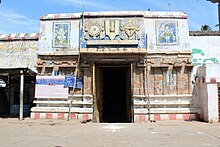Uthamar Kovil
| Sri Purushothaman Temple | |
|---|---|
Sri Purushothaman Perumal | |
 The shrine of temple | |
| Religion | |
| Affiliation | Hinduism |
| District | Tiruchirappalli |
| Deity | |
| Location | |
| Location | Tamilnadu, India |
| State | Cholas |
Uthamar Kovil (also known as Thirukkarambanoor or Bhikshandar Kovil) in Uthamarkoil, a village in the outskirts of
Purushottamar is believed to have appeared to Hindu gods Brahma and Shiva, to relieve Shiva off his sins committed while cutting one of Brahma's heads. The temple is one of the few historical temples in India where the images of the Trimurti, Vishnu, Shiva and Brahma are housed in the same premises. It is one of the two temples in Chola Nadu where the trinity can be seen in the same premises, the other being Hara Saabha Vimocchana Perumal Temple at Thirukkandiyur.
The temple is believed to have been built by the
Six daily rituals and four yearly festivals are held at the temple for each of trinities. The major festival of the temple, the Brahmotsavam, is celebrated during the Tamil month of Kartikai (November – December) when festival images of both Purushotamar and Bikshadanar are carried together in the streets surrounding the temple. The temple is maintained and administered by the Hindu Religious and Endowment Board of the Government of Tamil Nadu.
Etymology and legend

As per Hindu legend, the god Vishnu emerged as a Kadamba tree here, giving the name Kathambanur, which later became Karambanur. The name Karambanur is mentioned by Thirumangai Alvar in Nalayira Divya Prabandam, in which he refers to the presiding deity as "Karambanur Uthaman". The temple is commonly called "Uthamar Kovil" derived from the presiding deity. The temple is also called Bhikshandar Kovil as the god Shiva is present in the form of Bhikshandar (a mendicant) and believed to have attained cure by worshiping Vishnu at this place.[1]
As per Hindu legend, once Vishnu wanted to test the devotion of the god
As per another legend, Brahma and Shiva both had originally five heads. Parvati, the wife of Shiva, once got confused and worshipped Brahma, instead of her husband. Shiva got enraged and cut off one of Brahma's heads; the head stuck in Shiva's hand due to Brahma's curse. To atone for the sin, Shiva worshipped Vishnu here; Shiva was fully relieved of the curse after worshipping Vishnu at Hara Saabha Vimocchana Perumal Temple.[2][3]
According to another Hindu legend, the temple is believed to have been constructed by
Temple

The temple is believed to have been built by the
A granite wall surrounds the temple, enclosing all its shrines. The temples has images and separate shrines for Purushottamar (
The Saptaguru or seven gurus (teachers) are identified in the temple. The seven are Bhikshadanar (representing Sadasiva Guru, Shiva as a guru), Brahma (Brahma Guru), Soundarya Parvati (Shakti Guru, the Goddess as a guru), Brihaspati (Deva Guru, the teacher of the gods), Varadarajaperumal (Vishnu Guru), Murugan (Gnana Guru, the guru of knowledge) and Shukra (Asura Guru, the guru of demons).[1][5][6]
Festival and administration

The temple priests perform the
Religious significance

Uthamar Kovil is one of the two temples in Chola Nadu where the trinity can be seen in the same premises, the other being Hara Saabha Vimocchana Perumal Temple at Thirukkandiyur. Trimurti in Hindu mythology refers to the cosmic functions of creation, maintenance, and destruction. They are personified by the forms of Brahma the creator, Vishnu the preserver, and Shiva, the destroyer.[2]
The temple is revered in
Periyavachan Pillai, who translated the verses of Thirumangai Alvar, glorifies the temple as "the one without doors where devotees can always visit and worship".[1]
References
- ^ a b c d e f "Thirukoyil". 1. 15. Hindu Religious And Endowment Board Tamil Nadu. January 2013: 14–15. Retrieved 17 March 2013.
{{cite journal}}: Cite journal requires|journal=(help)[permanent dead link] - ^ a b T.A., Srinivasan (21 March 2003). "Temple for the Great Trinity". The Hindu. Archived from the original on 13 October 2003. Retrieved 9 September 2013.
- ISBN 9788120601512.
- ^ R., Dr. Vijayalakshmy (2001). An introduction to religion and Philosophy - Tévarám and Tivviyappirapantam (1st ed.). Chennai: International Institute of Tamil Studies. pp. 464–5.
- ^ M., Balaganessin (21 November 2010). "A seat to shun ego and seek wisdom". The Hindu. Archived from the original on 3 December 2010. Retrieved 17 March 2013.
- ^ a b "Sri Uthamar temple". Dinamalar. Retrieved 17 March 2013.
- ^ "Thirumangai Azhwar pasuram on Uthamar Kovil". Srivaishnava.org. Retrieved 17 March 2013.
